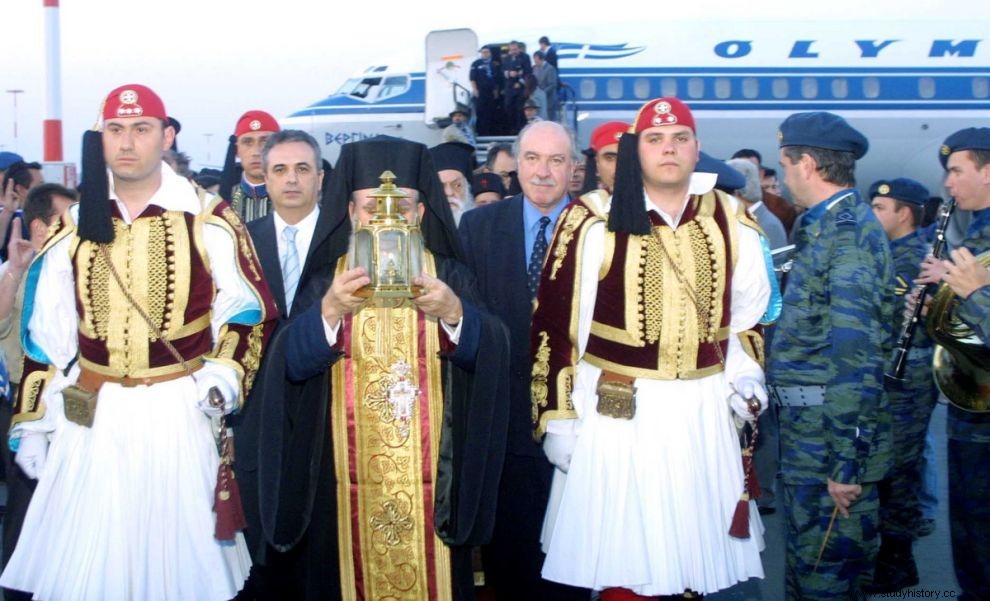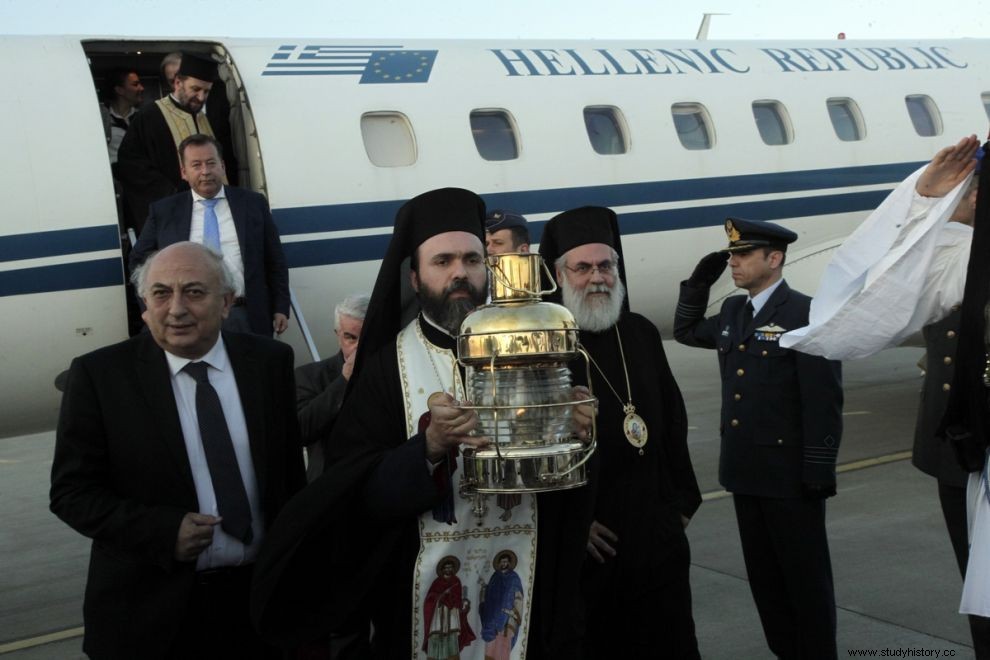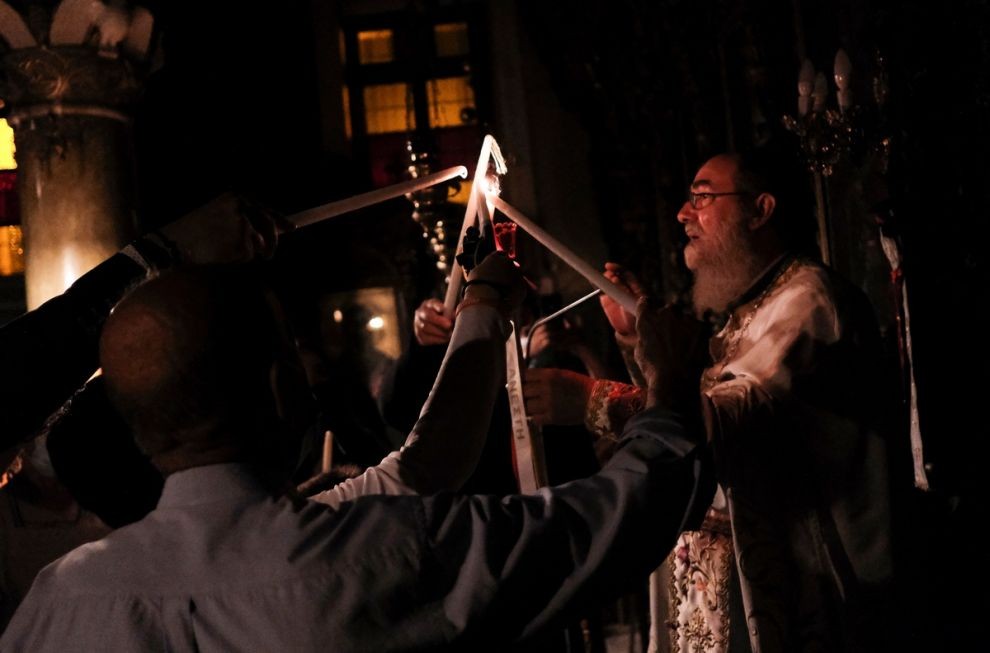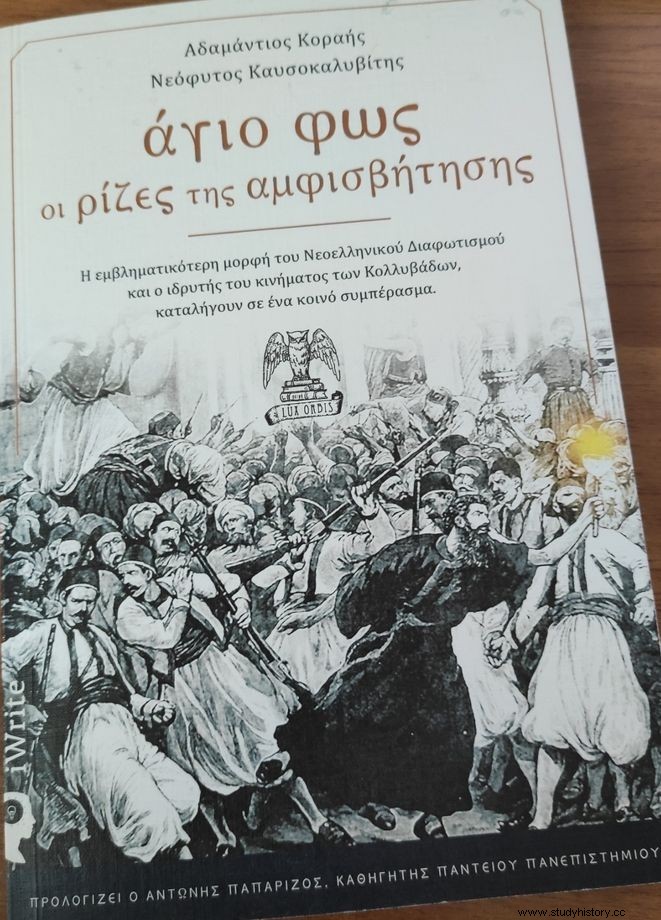It was in 1118 AD. when the Arab Salah El Din granted the orthodox monks the pilgrimages to the Holy Lands. El Din stipulated that "the patriarch of the Greeks will be the master of the Kamare (temple of the Holy Sepulcher) and he will take the Holy Light from the tomb of Icas to distribute it to the Nazarenes (Christians)".
This is how the jurisdiction of the Holy Light and its control passed to the Greeks.
Today, in the Orthodox Church, the fire ("light") which symbolizes the Resurrection is called Holy Light or Light of the Resurrection and is transmitted by the High Priest to the faithful during the Resurrection ceremony on Holy Saturday.
The flame burns inside the Holy Sepulcher. The Patriarchate called the whole ritual a "miracle" without clarifying whether the miracle is considered to be the consecration of the natural fire or the lighting itself.
The touching ceremony is a prerogative of the Greek Orthodox Patriarch of Jerusalem which is repeated every Holy Saturday at noon during the Resurrection service, at the Holy Sepulcher of Christ. It is attended by Christians of all denominations as well as non-religious people.
The ceremony of the Holy Light takes place at 12 noon on Holy Saturday.
Until 1988, the Holy Light arrived in Greece by ship a week after Holy Saturday. In 1988, on the initiative of travel agency owner Iakovos Economides, who was later awarded the titles of "Grand Lord Referendarios" and "Grand Cross", and in collaboration with Theodoros Tsakirides (later president of Olympic Airlines) and the then exarch of Panagios Tomb in Athens (and later Patriarch of Jerusalem) Irenaios began the transfer of the Holy Light to Greece by plane immediately after he touched down in the Holy Sepulcher with a special flight of Olympiaki, the expenses of which were covered by the Greek state. The air transport of Agios Fotos was carried out under the responsibility of a travel agency until 2001, when it was taken over by the Greek Ministry of Foreign Affairs (April 14, 2001, Holy Saturday during the Simitis government).

Thus, every year the exarch of the Holy Sepulcher of Athens receives the holy or "undead" light and takes it with a special flight to Athens, where until recently it was received with the honors of a head of state (since 2001) and then it is transferred to the Metropolis of Athens , as well as in a large number of other Metropolises.
The Holy Light is also transferred to other states where there are Orthodox Christians, such as Georgia, Ukraine, Romania, Russia, etc.
In 2017, for the first time, it was also transferred to the USA by flight from Moscow and delivered to three Orthodox Churches.
Political confrontation
The transfer of the Holy Light to Greece has often become a matter of political or party controversy.
In 2015, Nikos Filis commented negatively on the fact that the Holy Light is received with the honors of a head of state. At the same time, he made the same comment about the remains of Saint Barbara that were transferred to the "Agios Savvas" hospital in Athens.
In the same year, SYRIZA MPs had raised the issue of the cost of transporting the Holy Light. The Minister of Foreign Affairs N. Kotzias replied that the transport to the metropolises was done by a private company at its own expense.
In 2017 and other SYRIZA MPs criticized the transfer of the Holy Light as a "pseudo-miracle", but were negatively commented on by part of the press.

In 2014 the then deputy of the "To Potami" party, Nikos Dimos, left the party after he publicly expressed his opinion about the Holy Light (that it is a pagan symbol and that "As Easter approaches and I think that we will again spend money to bring the ( supposedly) Holy Light and to receive it with the honors of a head of state, I become an obsessive anti-clerical. And I suppose the same would have happened to Jesus, who for all we know, did not believe in pagan symbols - and would probably distribute the money to the poor".
This year, the government mission is being prepared to carry the Holy Light from the Holy Land. The transfer will be made by the government aircraft and the head of the mission will be the Deputy Minister of Foreign Affairs Andreas Katsaniotis. This year, there will be no restrictions on the reception due to covid, however for the second year it is expected that there will not be a reception with Head of State honors.
Upon its arrival in Greece on M. Saturday, the Holy Light will travel to every corner of Greece with the help of Aegean and SKY Express.

The "trick"
The journalist Dimitris Alikakos, in his book "Redemption - About the Holy Light" interviewed, among others, the custodian of the Holy Sepulcher who in front of the camera can be heard saying:"Listen. The candle is extinguished by me, the whole world he sees it through his television. But when the Patriarch enters the Holy Sepulcher, he finds it lit. I light it. With a lighter, what else?"
Another former custodian of the Holy Sepulcher seems, according to the book, to confess that he had lit the candlestick with a match, and in fact at the urging of the dragoman of the Patriarchate of Jerusalem.
Archbishop Gerason Theofanis also argued about the Holy Light:"It lights up in a natural way and is blessed by the Church. The time has come for the truth to be seen. The truth is always beautiful and hard".
Apart from Dimitris Alikakos' book on the Holy Light, many have referred to the touch as a "fraud" or trick.
The Patriarchate of Jerusalem, in the announcements of his Chief Secretariat regarding the ceremony of touching the Holy Light, he does not make any reference to the miraculous origin of the Holy Light, but indirectly seems to acknowledge the miracle, since on April 18th Saint Tunom the Emir, the Martyr, is celebrated.
The Metropolitan of Petra, Cornelius, vicar of the Jerusalem patriarchate in place of Patriarch Irenaeus, in an interview in 2001 on the show Gray Zones, he stated that the miracle is the sanctification of the natural light, which comes from the dormant candle, which already exists inside the Holy Dome.
"The wishes of the Patriarch have the power to sanctify the natural light. There is the natural and the supernatural light... it is natural light, which is kindled by the dormant candle within the Holy Shroud. A miracle is the invocation or prayer of the high priest and the light is sanctified".
The Grand Protopresbyter of the Ecumenical Patriarchate and Doctor of Theology George Tsetsis in the article "Legend and reality about the Holy Light" (To Vima, 4/21/2006 as retrieved by insidestory), wrote:"The patriarch lights his candle from the dormant candle that is above the Holy Sepulchre. Just as every patriarch and every clergyman does on the day of the Shining, when he receives Christ's light from the dormant candle that is above the holy table symbolizing the tomb of the Lord. But the mystery that was cultivated around the ritual of touching the holy light, and popular perceptions of it in our days contributed to the appropriation and exploitation by extra-ecclesiastical circles of this highly symbolic and all-consuming liturgical act of our church".
Professor Konstantinos Kalokyris, in his book The Architectural Complex of the Church of the Resurrection of Jerusalem and the subject of the Holy Light, interpreting the wish read by the Patriarch, he writes, after all, that "nowhere is there any talk (not even a hint) of a "light coming down from above" at the moment her, but only natural light is meant, which is lit in the memory of the Risen Christ" and that the holy light is simply "the holy symbol of the "eternal Light" of Christ, the Holy Light, the new Light of the Resurrection".
In the 18th century we have a reference to the history of the "miraculous descent of the Holy Light" by the Jesuit missionary (apostle) Du Bernart. In 1771 he sent a memorandum from Cairo to his immediate superior, the Catholic bishop of Toulouse. In the first part, he refers to the history of the ceremony, notes that it was an invention of the Latin kings of Jerusalem during the years of the Crusades and adds how it was then used by Orthodox priests.
At the beginning of the 19th century, Adamantios Korais, along with most of the traditions and practices of the Orthodox Church, rejected the interpretation of the holy light as a miracle, arguing that it was a machination and "fraud" for financial gain (although he himself had no ever travel from Paris to Jerusalem to attend the event).
The roots of doubt

These days, after all, the book entitled "Holy Light:The Roots of Doubt " (iWrite Publications, Lux Orbis), which includes the texts of the great Enlightener, Adamantios Korai , "About the holy light in Jerusalem" (1826), as well as the cleric and founder of the Kollyvada movement, Neofytos Kaufsokalivitis , "On the epitaph of light" (1755). Both thinkers come to a common conclusion. There is no kind of miraculous process, while the whole event becomes the object of financial exploitation by the Jerusalem patriarchate. This original study is prefaced by the professor of Sociology at Panteion University, Mr. Antonis Paparizos. . In the book you will also read the epitome of the editor of the publication, Mr. Fotis Fragopoulos .
The book was even discussed on the show of Petros Tatsopoulos on the First Program of ERT, in the show he did together with the publisher of the Lux Orbis series, Minas Papageorgiou, in a presentation that caused reactions from conservative circles.
As reported by the publishers, in our days, with the recent admissions of the Holy Sepulchers having solemnly confirmed Korai and Kausokalyvitis, the value of this book is twofold. On the one hand, he presents us with the roots of questioning the miracle in the pre-revolutionary world of the Greek intellectuals, and on the other hand, he calls on the modern representatives of the Greek - and theoretically secular - state to definitively clarify the situation regarding the annual reception of the candle by Israel, with the honors of a head of state.
Adamantios Korais (1748-1833) was a Greek physician and philologist. From 1788 until the end of his life he lived in Paris, experiencing the events of the French Revolution, which decisively influenced his thinking. A member of the Society of Human Observers, he translated the Declaration of the Rights of Man and other legal and political texts.
It evolved into a central form of the Neo-Hellenic Enlightenment. Influenced by the liberal ideas of the European Enlightenment, he fought with his writings in favor of the intellectual renaissance of Greece; an event he considered a necessary condition for its independence. His teaching was a milestone in shaping the later spiritual and political thinking of the Nation. The 66 volumes of books he published caused the admiration of foreign philologists and at the same time nourished the Neo-Greeks with the threads of ancestral wisdom.
Neophytos Kaufsokalyvitis (1689-1784) he was a priest, the author of many books with theological content, while he is considered the founding figure of the movement of the Kollyvada monks of the holy Mount. In the middle of the 18th century he was the director of the Athoniada Academy. He also taught in Chios, but also in Wallachia, where he lived a large part of his life, until his death in Bucharest.
